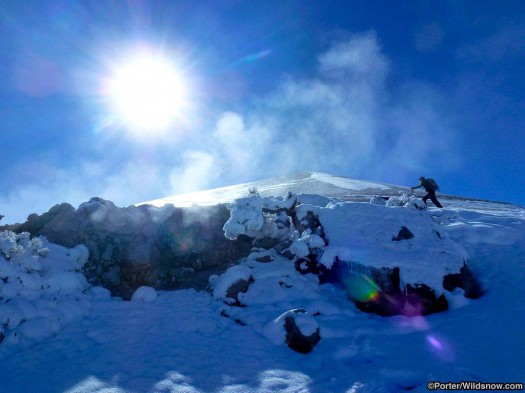
Desperate conditions call for exploring the obscure. Mike Phillips winds through volcanic steam east of the Sierra. February 3, 2014
For anyone even remotely tuned in, I need not elaborate much on the state of skiing in California’s High Sierra. In short, it has been a grim year. It started off slow, and remains exactly that. Storms have been small, with huge gaps between them. And I mean huge gaps. The unprecedented drought of December 7, 2013 to January 30, 2014 felt like a lifetime. A miserable, tedious lifetime. Nonetheless, adventurous skiers are getting out, especially as the February snow gradually accumulates. Rumors from the first weekend of the month, really the first notable backcountry ski weekend of the season, delivered news of mega traffic to the standard-for-many, season opening tour to the pumice slopes of Red Cone on the Mammoth Crest.
Mike and I weren’t content to settle for Mammoth Crest action. I’d already squeezed in a few tours there earlier in the season and Mike has a twisted sense of adventure. Mike scopes the corners of the range while on the clock as a Mammoth Mountain patroller. I am learning to readjust my travel patterns following a recent move from Bishop to Mammoth.
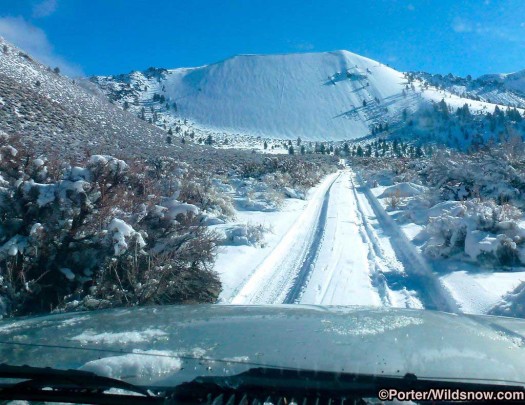
A blank canvas beckons. It is no mystery why the early season Sierra skier heads to the volcanic topography. Smooth, small substrate skis sooner than the big bony peaks.
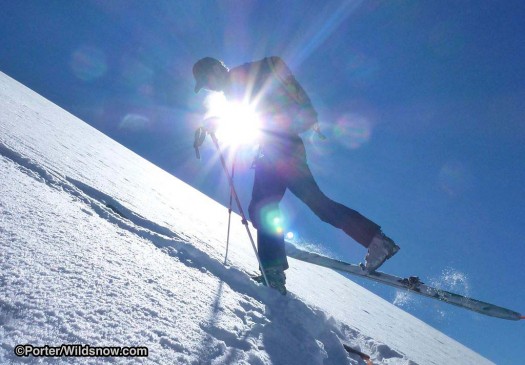
Skinning up was enjoyable, but a bit alarming. "This is just a few inches of snow... It must be deeper over there. We'll be fine..." Thus goes the blind optimism of the eager.
Aside from a couple spits of snow, the Sierra was indeed dry for most of December and January. On the 30th day of 2014, it finally snowed. It was a warm storm with characteristic wind and distribution patterns. Mammoth gets the most, while south, north, and east get less. The ski area was frightening, with thinly covered rocks and equally alarming (though also welcome) poor attendance. I have never skied so much untracked inbounds snow as I did on Friday the 31st. Nor had I ever done so much base damage. Things cleared slightly over the weekend, with a little “Tonopah Low” bringing another few inches on Sunday. This type of storm brings “wrap-around” precipitation, often augmented by a little Mono Lake effect. The peaks of the Mono Basin from Lee Vining to June Lake, as well as Mammoth Mountain again, often benefit from this light, cold precip. Optimistic, I got my skis repaired.
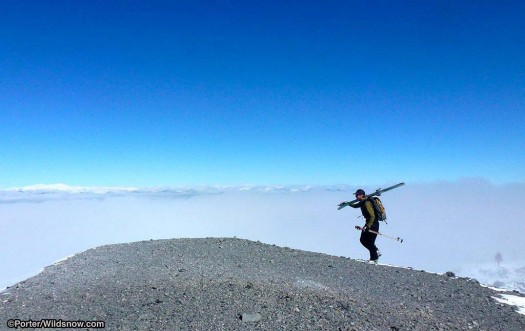
An east wind had stripped the top of our intended peak, and hopefully deposited a deeper layer on our intended slope. Wishful thinking. More optimism.
Come Monday morning, the storms had cleared out. Mono Lake was hidden under its characteristic, high pressure “pogonip” fog with bright blue skies overhead. Someone had already sampled the skiing on our intended slope. In full view of the highway, this volcano stands out year-round. In the summer, a prominent discolored stripe of scree stands out, presumably from some sort of landslide. On this day, three sets of tracks and a stripe of loose-snow avalanche marked the broad face. We could drive right to the base. The skinning was easy and fast. The 1,200 foot ascent, through big views and the occasional wisp of fog and junipers, went quickly.
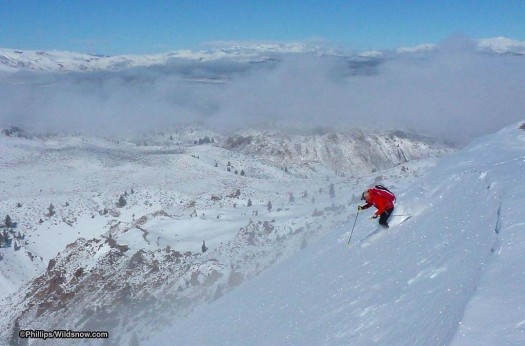
The author in his first turn. Mono Lake under the fog in the background. Every turn on the run was excellent, but this was the only optimistic one.
We leapfrogged down the face, enjoying strangely excellent ski sensation. The conditions were predictable, fast, and photogenic. The auditory experience of this particular ski run was notably unique, however.
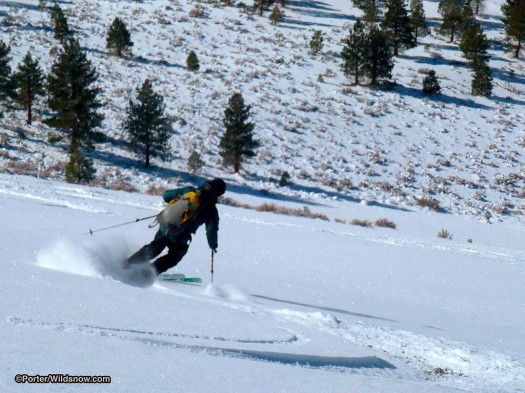
Mike letting it loose. He pulled his skis from the truck this day and proudly proclaimed "This is the first they'll touch snow."
Now, on the ascent I had remarked “If the skiing is just 10% as good as the scenery and position, today will be a success.” As it turns out, the ski quality far exceeded those low expectations. It still blows my mind how good a time we had. Both Mike and I are thrifty people. We work hard to make the pennies required to live here. We choose and maintain our gear carefully, to make it last. In my case, damaging gear is a buzzkill. And these were gear-damaging conditions, to say the least. However, the sensation of skiing this particular pane of white overwhelmed any sort of regret for the ongoing ski destruction.
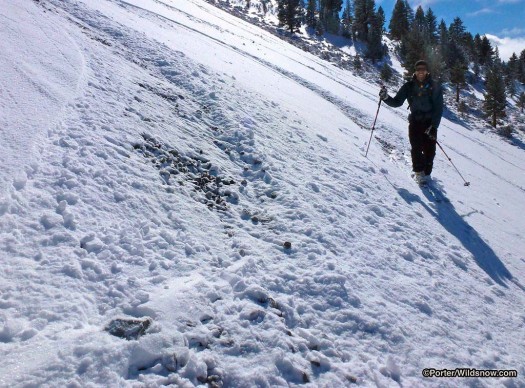
Every turn looked like this. No joke. I did joke, however, that this is probably the most fun a guy can have with four inches.
We laughed. We had no need to discuss another lap. We speculated on the experience of the authors of the other tracks on the mountain. We compared damage to ski bases. My newly patched and tuned skis were scratched end to end and side to side. They might have enough base and edge for another tune. Maybe. Mike said “This scratch is a different color… oh, that’s some pumice still in there.” Miraculously, neither of us went to the core. In over a thousand feet of skiing as much rock as snow, we didn’t fully ruin our skis. It does, however, set the tone for the rest of the season. Even if the faucet turns on, we’ll have weird conditions. We’ll ruin gear and explore new corners and get creative.
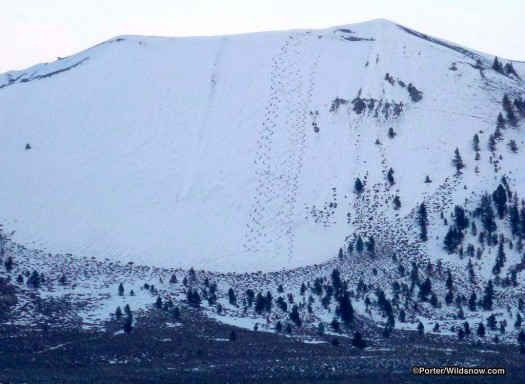
I worked in Lee Vining a few days later. As it turns out, three days of sun on the slope had melted our tracks out completely. I snapped this picture while driving by. The tracked snow is gone entirely, showing our whacky mark in stark relief. Tracks melting out to the ground; how often does that happen?
(Guest blogger Jed Porter is a full-time, year-round mountain guide in Mammoth Lakes, California. He wouldn’t say no to a turns-all-year schedule, but he sure enjoys the variety of mountain adventure that life in the High Sierra provides.)
Jed Porter is a passionate adventure skier and all-around mountain professional. His primary work is as a mountain guide, skiing and climbing all over the Americas and beyond. Learn more about him at his website linked below.
